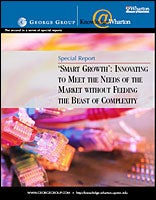Looking for more insights?
Sign up to stay informed about our latest article releases.
It seems all too obvious that companies shouldn't spread their innovation resources too thin. Experts from George Group Consulting and Wharton note that firms investing in product and service innovation, but not process innovation, can miss out on capturing the initial gains of market share.

Sign up to stay informed about our latest article releases.